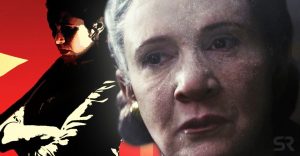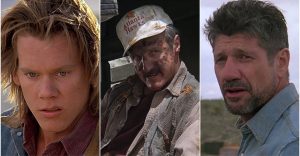The Mandalorian: What Are Ahsoka’s Head Tails Made Of

The Mandalorian introduces former Jedi Ahsoka Tano to live action, but doesn’t explain much about the character, like what her head tails are made of, or what they’re for. Rosario Dawson made her debut as Ahsoka in The Mandalorian, season 2, episode 5, “Chapter 13: The Jedi.” The episode was informative — revealing that the true name of Baby Yoda is Grogu and that his backstory involves the Jedi — but little is revealed about Ahsoka herself. For viewers unfamiliar with the Star Wars universe outside the core movies and the Disney+ series, the character is largely a mystery.
Ahsoka is a fan-favorite character from the animated series Star Wars: The Clone Wars and Star Wars Rebels. Although she is a mature adult by the events of The Mandalorian, her tenure in the franchise began when Ahsoka was just a child: A former Padawan of none other than Anakin Skywalker, Ahsoka Tano’s Jedi journey is explored in Clone Wars and Rebels. The shows follow her training in the Jedi Order, her eventual disillusion with its leadership, and her choosing to leave the Jedi, instead seeking a more balanced role for herself in the universe. Ahsoka remains loyal to the Jedi, but — as shown in The Mandalorian — she chooses to act as an independent agent.
Ahsoka’s backstory is fairly developed via Clone Wars and Rebels, as well as the rest of the Star Wars Expanded Universe. Ahsoka is an alien species known as the Togruta, native to the planet Shili. The first appearance of a Torgruta was the Jedi Master Shaak Ti, who was introduced in Star Wars: Episode II – Attack of the Clones. Like Ahsoka, Shaak Ti has red skin with white markings, and white and blue head tails, or “lekku,” with pointed horns on top, called “montrals.” This isn’t a headdress, but is actually a part of her body — appendages that may even help Togruta like Ahsoka Tano and Shaak Ti access the Force.

Lekku in the Star Wars universe are fleshy appendages, sometimes compared to tentacles, that are found on the species Togruta and Twi’lek (like those seen in The Mandalorian season 1), as well as males of the species Ozrelanso. A Togruta’s head tails are unique in that they actually have three — two lekku on either side of the head and one “lek” down the back — while most others have two (although in rare occasions, a Twi’lek is seen to have four). Twi’lek head tails have been described as highly sensitive and even prehensile, and some Extended Universe content suggests that a damaged lek can be fatal. Ahsoka’s head tails are not shown moving in “The Jedi,” and currently, it’s unclear whether or not they pose a vulnerability for her — although if they are a sensory organ, it’s not unreasonable to assume that she may use them to help her access the Force.
In addition to the head tails, Ahsoka actually has another structure at the top of her head: montrals. These are sensory organs found on the heads of the species Togruta and Kessurian, and are used to sense movement. Ahsoka Tano’s montrals (in live action) are significantly smaller than those on Shaaki Ti, which may indicate that Ahsoka is significantly younger (as montrals grow with age) or even that Shaaki Ti had better developed perception. Ahsoka’s head tails were shortened in The Mandalorian because of all the stunt work required for the action sequences, but it does make some sense in-universe that a life of active combat would discourage growth, compared to Shaaki Ti, who as a member of the Jedi High Council during Galactic Republic, likely spent less time in physical battles than diplomatic ones.
About The Author


















